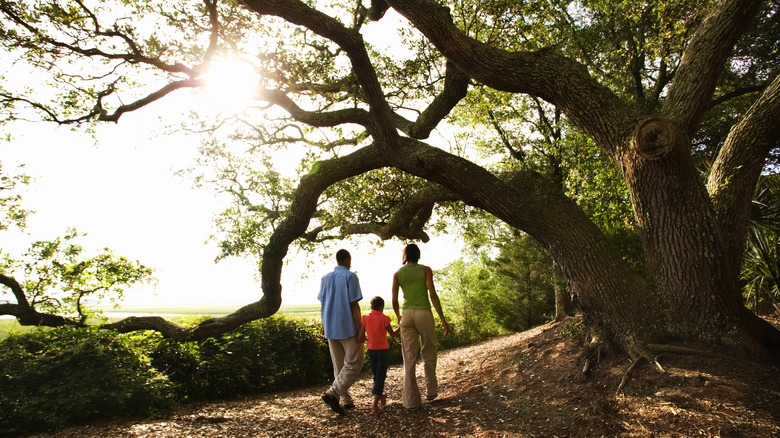A multi-trunk tree, also known as a multi-stem or clump-form tree, has a distinctive appearance characterized by several trunks growing from a single root system. Instead of the single, dominant central trunk, these trees have multiple of similar size and stature. Depending on the species and growth conditions, these trunks can number from two to many. Multi-trunk trees occur in two ways: naturally or through human intervention. In the wild, these often result from damage to a young tree, where the primary trunk is destroyed or damaged, and the tree compensates by growing multiple new stems. In managed landscapes, gardeners can encourage this growth by pruning a single-trunk tree or planting trees that are predisposed to multi-trunk growth.
Due to the multiple trunks, the canopy of these trees often appears fuller and broader than that of single-trunk trees, while the overall size depends on the species, age, and growing conditions. Mind you, this is not to be confused with shrub-form trees, which are essentially small flowering ones (under 15 feet tall) with many thinner branches growing from the base.
Benefits and meanings of multi-trunk trees

Indeed, from a landscaping perspective, multi-trunk trees are often chosen for their aesthetic appeal. They add an eclectic element to gardens and yards and can be used as a focal point in landscape design, drawing the eye and adding character to the space. At the same time, there are practical benefits too. Due to their dense branch structure, multi-trunk trees can serve as natural screens, providing ample shade and privacy during hot summer days. This dense foliage can also act as an effective noise barrier, offering a quieter and more serene environment than what single-trunk trees typically provide. More importantly, however, trees with multiple trunks provide diverse habitats for wildlife, including birds and beneficial insects, especially in the city or suburban areas, as the numerous nooks are ideal for nesting and shelter. At the same time, their extensive root system is very beneficial for soil health and stability.
Beyond their physical presence, specific multi-trunk trees hold various cultural and symbolic meanings. For example, take the multi-trunk Dogwood tree, which embodies concepts like secrets, loyalty, protection, and wishes, or the clump-form Alder tree for its mythological significance in Celtic cultures, renowned for its connections with fairies. These trees have always been open to interpretation. For this reason, the next time you’re caught staring at the profound beauty of a multi-trunk tree, be intuitive with your thoughts and feelings, then begin your research.
Cultivating your multi-trunk tree

To cultivate your own multi-trunk tree, start by selecting the right species. For beginners, we advise one that is naturally inclined to multi-trunk growth, like Juneberry or Japanese Maples. However, do your research and perhaps find one that holds significance to you. Experts recommend starting with a two-year-old tree and cutting the main stem about three inches above ground level. This will create new trunk growth. As you continue to encourage this growth form by pruning the central leader, you will stimulate the development of lower branches.
Furthermore, a dedicated care regimen ensures your multi-trunk tree’s successful growth. Young trees, in particular, require consistent watering, ideally every two days, to develop a robust root system. Additionally, applying mulch around the tree’s base is beneficial for retaining soil moisture so long as it’s not on the bark. Lastly, remain vigilant against pests or diseases to ensure the continued health of your tree. With diligent care and attention, your tree is set to become a magnificent feature in your garden. Whether it’s the secret-harboring Dogwood or the fairy-associated Alder, these trees can be a magnificent addition to your yard.



